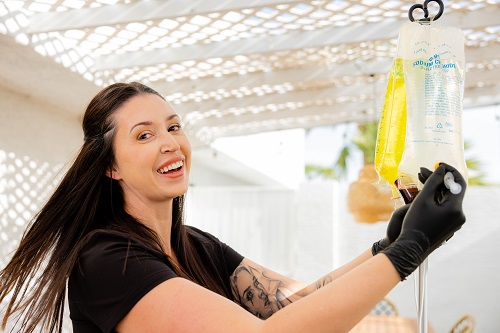
IV Treatment for Big Events and Private Parties
May 25, 2022
The 2 Most Common Types of IV Fluids
June 1, 2022Table of Contents
IV therapy is an exciting wellness tool, but it may also seem daunting to people who haven’t tried it before. They may have heard of everything from mild bruising from an IV to an allergic reaction. While treatments are generally safe, as with virtually any medical procedure you may run the risk of complications with IV therapy. That’s why it’s important to work with a trusted, experienced provider like Mobile IV Nurses.
Knowledgeable IV therapy companies like us know the proper procedures and safety guidelines that help minimize risk and ensure you have a comfortable therapy experience. Medical professionals administer all of our IV treatments, so you know that you are in good hands.
Here are some of the most common concerns first-time patients may have.

Infiltration
With IV therapy, fluids move down from a bag through a drip line and into an IV port in a vein in your arm. From there, the fluids enter the bloodstream to hydrate the body and deliver the drip bag’s vitamins, minerals, or other supplements.
On occasion, however, the fluids accidentally leak from the vein into the surrounding tissues. This is IV complication is called infiltration. Typically, infiltration occurs when the catheter for the IV port isn’t inserted into the arm properly, or the patient moves, dislodging the port.
Common signs: The skin at the insertion point may redden or turn lighter (a term called blanching). There may also be swelling, tenderness, or some pain. The IV can stop working as well.
How it’s treated: The IV port is removed and a compress applied to ease any pain or tenderness. Elevating the arm may also reduce swelling. Post-care instructions should be given to avoid possible complications.
Steps we take to prevent it: Our team members carefully select the IV site and insert the catheter for the port. They also monitor patients throughout the infusion to ensure the port stays securely in place.
Extravasation
Extravasation is similar to infiltration, as both involve fluid leakage. The difference is in the type of fluid in the IV.
Extravasation involves fluids, specifically medications, that can irritate or inflame the tissues in the body. These are called vesicant medications. There are several types of these medications, including phenobarbital, epinephrine (or adrenaline), and many chemotherapy drugs.
Common signs: Many of the symptoms are similar to infiltration, such as swelling or pain. The irritating effect of extravasation may also cause the skin at the insertion point to feel cold or hot. Blistering or other skin damage, as well as infection, may occur.
How it’s treated: Treatment will vary somewhat, depending on the medication and the extent of any subsequent injury. In any case, the IV provider should immediately stop treatment, flush the medication from the area, and administer an antidote that neutralizes the medication’s effects. Pain relievers may also be offered, and follow-up care is typically recommended.
Steps we take to prevent it: Mobile IV Nurses uses only one medication deemed a potential irritant (Zofran, or ondansetron). Our team members — many of whom have experience as paramedics or emergency room nurses — understand how to work with this medication and treat any potential problem accordingly.
Air Embolism
An air bubble in an IV doesn’t happen often, but it can be a rare complication with IV therapy if the air bubble enters the vein. An air embolism can be dangerous if it reaches the brain, lungs, or heart and causes a life-threatening problem such as a stroke or heart attack.
Common signs: The severity of symptoms may depend on how much air has been introduced into the vein and the location of the embolism. Signs include low blood pressure, chest pain, headaches, muscle pain, confusion, and impaired breathing.
How it’s treated: A small air embolism can dissolve on its own, with no further action needed. A major air embolism that can block blood flow requires immediate treatment, such as surgery.
Steps we take to prevent it: Hanging the drip bag in the proper vertical position can reduce the risk of an air bubble in an IV. Our close monitoring of the patient during treatment also keeps us alert to any potential problem signs.
Phlebitis and Thrombophlebitis
A damaged vein may become inflamed, causing phlebitis. This irritation can be triggered by a poorly placed catheter for the IV or by a medication in the IV bag. Thrombophlebitis also causes inflammation, and it can occur if you develop a blood clot in the vein after IV treatment.
Both phlebitis and thrombophlebitis can lead to infection at the IV site if left untreated.
Common signs: The skin near the inflamed vein can feel warm, tender or swollen, and the vein itself may feel hard or ropy. You can also expect some pain or tenderness.
How it’s treated: It helps to elevate the affected arm and use a warm compress to reduce discomfort. You may also take ibuprofen for pain relief, or a physician may prescribe medication.
Steps we take to prevent it: We make sure to use the right catheter size when inserting the IV port to avoid damage to the vein. If you have used IVs many times, we may also find a different insertion site to prevent vein irritation from overuse.
Hypersensitivity
This is a serious allergic reaction to the IV medication. This involves anaphylaxis (closing of airway and other problems), so treatment must be administered immediately to prevent life-threatening complications.
Common signs: Typical symptoms include fever, rash, swollen joints, and restricted breathing.
How it’s treated: Immediate medical attention is required. Specific treatment depends on the symptoms and their severity.
Steps we take to prevent it: Again, careful monitoring is key. We also take a patient’s health history before treatment so we know of any potential allergens to avoid.
Infection
Bacteria is the culprit behind infections at an IV site. It can be caused by improperly sterilized IV equipment or a provider’s lack of hygiene.
Common signs: Skin at the injection site turns red and there may be some slight pus discharge. Fever is another common symptom.
How it’s treated: Medication such as antibiotics are prescribed to eliminate the infection.
Steps we take to prevent it: Our medical professionals follow best practices for safety and hygiene, using only sterilized and clean equipment.
Choose Mobile IV Nurses for Safe IV Therapy
Our medical expertise makes Mobile IV Nurses the leader in IV therapy. Want to learn more about us? Contact us today or book online for safe and effective IV treatment.

FAQs
What are the complications of IV therapy?
IV treatment is a generally safe therapy used daily by millions of patients. However, there is always a potential for complications. There is always a minor risk of infection with IV treatment.
A burning sensation around the IV site may indicate extravasation. This occurs when the cannula inserted is too large for the patient and fluid leaks out.
Elderly patients or those with kidney issues are most vulnerable to hypervolemia. This involves an abnormal blood volume increase, resulting in tachycardia (rapid heartbeat) and neck vein distention.
Phlebitis is a rare complication that can turn serious. It is an inflammation of the vein. Nurses can prevent phlebitis by using the smallest possible needle for insertion.
What are the most common problems associated with IV therapy?
A swollen hand after IV treatment is the most common problem associated with IV therapy. Besides swelling, symptoms may include warmth and redness around the vein. The area around the vein may prove painful.
Some patients may develop a hematoma or pool of clotted blood resembling bruising at the IV site. Applying ice for relief.
What precautions do nurses consider in an IV therapy?
Nurses begin by reviewing the physician’s order, including the type of infusion solution. For instance, the solution for IV vitamin therapy differs considerably from IV treatment for migraines.
Before inserting an IV, nurses follow a standard procedure to keep patients and themselves safe. Prior to insertion, nurses wash their hands with antimicrobial soap or use alcohol-based rubs for disinfection.
Next, they gather and prepare the IV equipment. Their checklist includes:
- Ensuring the fluid has not passed its expiration date
- Inspecting the container’s integrity
- Inspecting the administration set and choosing the appropriate set
- Gathering venipuncture supplies and dressings
The nurse introduces themselves to the patient and confirms the client’s identity. If necessary, they will provide privacy for the patient, although this is less of an issue with IV therapy in the patient’s home.
The procedure is fully explained to the patient That includes a warning that the insertion of the IV into the vein may cause a few seconds of discomfort.
Veins are then assessed, and the venipuncture begins. All nurses wear gloves during the procedure. The insertion site receives cleansing with an antimicrobial solution prior to needle insertion.
What should I monitor during IV infusion?
During the infusion, the nurse frequently monitors the client’s fluid and electrolyte balance. This avoids possible complications, such as excessive fluid or electrolyte imbalance. Vital signs are monitored throughout the session.
The nurse also notes any changes to the skin during IV treatment. This may include:
- Skin tightness around the IV
- Fluid leakage
- Temperature changes
The client should let the nurse know immediately if they experience any discomfort. If you notice anything amiss, such as fluid leakage, let the nurse know right away. If you have any questions about the procedure, ask the nurse. They are happy and willing to answer all of your questions before, during, and after IV treatment.
Experience the Convenience of At-Home IV Therapy with Mobile IV Nurses
Hydration & Wellness
Professional Care
Convenient Service




